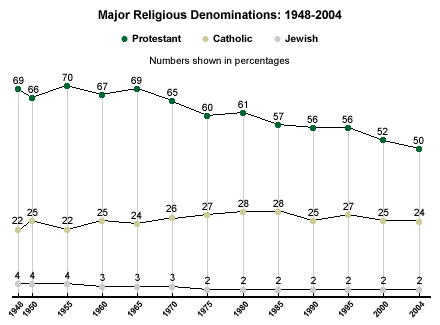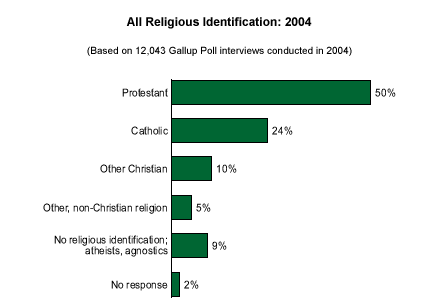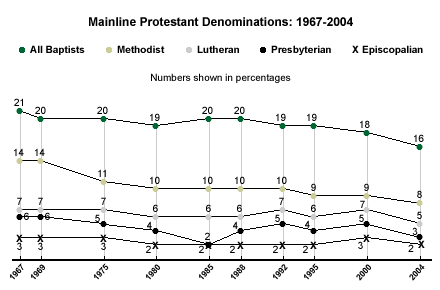Religion may be as old as humankind, but it is certainly neither static nor simple. In 1948, Gallup began asking Americans about their religious preferences using a question that seemed to cover all the major faiths in the United States at the time: "What is your religious preference -- is it Protestant, Roman Catholic, or Jewish?" Sixty-nine percent identified as Protestant, 22% identified as Catholic, and 4% identified as Jewish 1948.
If we focus solely on responses in those three categories, the following nearly 60-year trend shows a significant decline among Protestants, a slight downturn in the number of Jews, and a gradual increase followed by a gradual decrease in the percentage of Catholics.

More Religions Offered
In the early years, Gallup limited its data on religion to just five categories -- Protestant, Catholic, Jewish, "other" and "none." All non-Catholic Christians were coded as Protestants. But beginning in the mid-1970s and to the present time, Gallup has revised its religion demographic to capture more detail. In 1977, Gallup added "Eastern Orthodox" to the list of religious preferences offered, and soon after began separating out Mormons from the Protestant category in the coding of the question (Mormon was made an explicit option in 2000). Significantly, Gallup began coding those who said they were "Christian" but did not specify a religion as a separate category in 1999, and the number falling into that category has grown since.
While Gallup had always given people the option to say they did not identify with any religion, it was made explicit in 2000. The current question, adopted in 2000, asks "What, if any, is your religious preference -- are you Protestant, Roman Catholic, Jewish, Mormon, Muslim, or an Orthodox religion such as the Greek or Russian Orthodox Church?"
The percentage identifying as Protestants has clearly declined in the United States since the late 1940s, but the number of non-Catholic Christians has been stable around 60% since the early 1980s. In that time Catholic identification has fallen off slightly, from the high 20% range to the mid-20s. The number of Americans with no religion has increased steadily, with the increase showing even before the wording change in 2000.

Probing Protestants
Beginning in 1967, if a respondent identified as "Protestant," Gallup asked, "What specific denomination is that?" In addition to the mainline Protestant denominations -- Baptist, Methodist, Lutheran, Presbyterian and Episcopalian -- respondents also name other religions: "Church of Christ," "Pentecostal," or "non-denominational."
Every mainline Protestant denomination has lost members in the last four decades (see "Factors in the Slide of Mainline Churches" in Related Items). Methodists and Baptists have lost the most members, Presbyterians and Lutherans slightly fewer. Episcopalians, always the smallest Protestant mainline congregation, have remained at the same level since 1967.

The Baptists
In 1992, Gallup began to separate Southern Baptists from other Baptists. While the percentage of people identifying as Southern Baptist has declined since 1992, the percentages who associate themselves with other Baptist denominations have remained relatively stable.
Bottom Line
This Gallup question spurs interesting discussions about many of the religious faiths measured. For instance, Jewish organizations like to point out that even though there is a much smaller percentage of self-identified Jews in the American population than there was 50 years ago, the actual number of Jews has remained stable at around 5.5 million. Intermarriage and a general trend of Jewish assimilation with both secular and Christian culture are possible factors contributing to the decline of Jewish identification.
